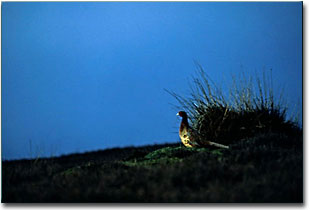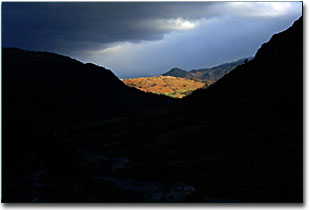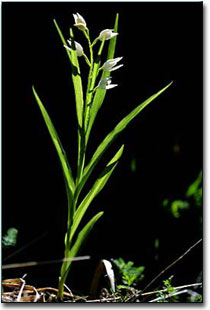
I suppose all photographers enjoy the sunny days of summer. Bright light and blue sky means that fast shutter speeds and slow, fine-grained film can be used. We can freeze the action and show fine detail - isn't that the ultimate dream of wildlife photographers? Alternatively, we have all known days when the weather is less than perfect, when it seems quite normal to want to stay at home in front of the T.V. But we should not allow ourselves to be robbed; those days can be the best of all.
If it's difficult to get out when the weather is less than perfect then it is even more difficult when rain is hammering down. I admit that it does seem kind of pointless to head out on days of endless rain, but it's at the edge of a storm when light can be most interesting. One of my favourite photographs was taken under such conditions. Overnight heavy rain had been forecast to break around dawn and I drove out to nearby moorland hoping to make something of the change. Driving along slowly in the patchy rain, with my camera at the ready, I was continuously looking for something to photograph. The only hint of sunlight was where cracks in the cloud allowed a few "God beams" to burn through, creating small patches of brightness that scurried across the ground, until the cracks filled in. Suddenly in the distance I heard a male pheasant warning his harem of my presence. A pool of light was shooting across the ground towards him. I quickly drove into the best position that I could, lifted my camera, focused, and waited hopefully. Caught as in a spotlight, the pheasant's golden plumage shone for an instant when all around him was steel grey. Immediately after firing the shutter the light was gone.

For years the sort of light I adored for photographing mountains was bright and contrasty. Side-lit under these conditions the smallest cracks and crevices can be picked out. Rugged rock faces looked three dimensional in the extreme as each shadow fell into darkness. And if I also used a polarising filter, shadows were not only dark but seemed to actually suck light out of the photograph. I would hate clouds, clouds meant shade and loss of contrast, and the effect I so loved vanished in an instant. Then I discovered the edge. As wispy clouds sail across the sun, their leading edges first feathers the light before filtering it out. At this moment a beautiful softness is created. Although soft, this light retains its directional aspects and the mountains look no less rugged. Additionally, light now finds its way into the cracks, showing details that otherwise remain unseen. Somehow this allows more of a story to be told in the photograph. This is now my favourite light for photographing rugged mountains. Unfortunately it only happens occasionally, and when it does it usually only lasts a couple of seconds so I have to be ready for it.
There is another edge, one that we are all familiar with. It's the one that defines night and day. This single edge wraps around the globe and we experience it twice a day, and it has always held a particular fascination for photographers. Sunsets are worthy photographic subjects in themselves but for me it's being close to this edge rather than at it that inspires me the most. The couple of hours after sunrise or before sunset, where light takes on the golden glow that speaks to us of fire and warmth - of comfort and safety, that's when I enjoy my photography most. This is particularly true if I'm photographing mammals as their fur seems to take on a special glowing characteristic of its own. And of course, this is also the best time of day to photograph the crepuscular animals.

Have you noticed how hard it can be to isolate a subject from its background? There are many techniques that we can apply to try and achieve this, such as differential focus, selective positioning or choice of lens focal length. My favourite is placing light against dark. What I mean is getting my subject in light and the background in shade. Specifically, where the exposure difference is two stops or more. By exposing for the highlights any shaded areas will fall into darkness with all details become subdued. To do this I have to find conditions that allow me to work on the edge of darkness. To achieve this I have to be in the right place for shadows to fall where I want them, or have a situation that allows me the luxury of a choice of position. If I'm dealing with a small static subject I may even use something such as my camera bag to create a shadow. But where I like to use this edge the most of all is on backlit vegetation. Positioning leaves lit this way against a dark shadow almost makes them glow, giving vibrant colour and added depth.
It is always worth looking out for these sorts of opportunities. I know that I do. And the sense of satisfaction I get with each successful photograph encourages me to seek them out even more. I suppose I'm trying to use an edge intelligently to give my photographs the edge.
About the images...
Pheasant (Phasianus colchicus torquatus)
This is the photograph described in the second paragraph. Taken in a hurry from my car.
North York Moors, England
Canon EOS3, 500mm, 1/60@f5.6, Fuji MS100/100@100, beanbag on car window.
Borrowdale
Storms rolling across the mountains only allowed infrequent patches of sunlight to illuminate the ground. But when they did the effects were often spectacular.
Lake District, England
Canon EOS5, 28mm, 1/125@f8, Fuji Sensia 100, tripod.
Narrow-leaved Hellborine (Cephalanthera longifolia)
Taken on a bright day with the sun ahead and to the right. Surrounded by grass and woodland detritus this single flower didn't stand out much from its background. I placed my rucksack out of shot to create a shadow, thereby isolating this flower and showing its attributes at their best.
Aragon valley, Spain
Canon EOS3, 100mm macro, 1/125@f5.6, Fuji Sensia 100, tripod.
Editor's note: Stephen Street is a NPN reader who resides in the United Kingdom. Be sure to sure to stop by and peruse his personal web site.

